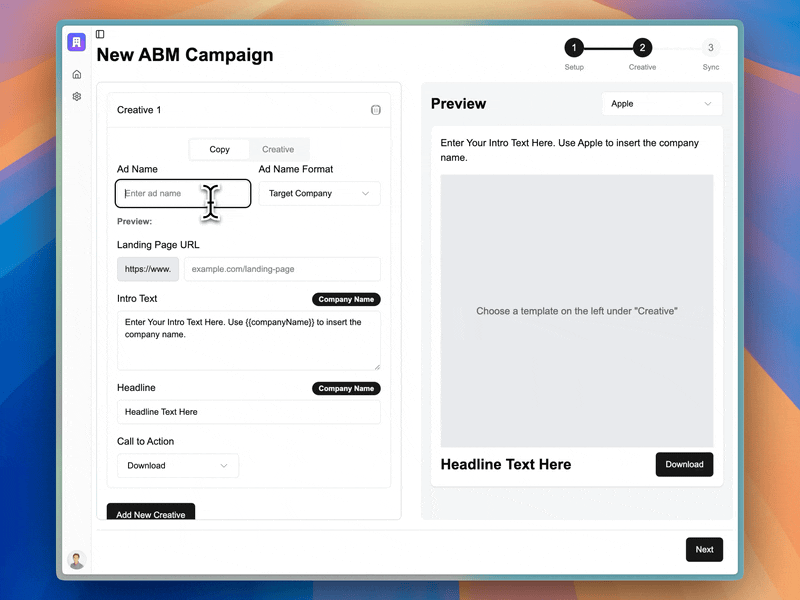In times of economic uncertainty, businesses face difficult decisions about where to cut costs. According to the World Economic Forum, marketing budgets are often the first casualty when recession looms, with 91% of U.S. economists now expecting weak economic growth and 63% anticipating a potential global recession. However, historical data consistently shows that maintaining—or even increasing—marketing spend during downturns is one of a business’s smartest moves. Digital marketing, in particular, offers unique advantages that make it not just a survival tactic during a recession, but a strategic opportunity to gain market share and position your business for accelerated growth when the economy recovers.
Key Highlights
- Competitive Edge: Companies that maintained marketing during past recessions saw up to 340% sales growth in the recovery period
- Budget Optimization: Digital channels offer precise measurement and higher ROI than traditional marketing during economic uncertainty
- Consumer Behavior Shift: Recession drives increased online research before purchases, making digital presence more critical
- Strategic Positioning: When competitors cut marketing budgets, maintaining visibility creates market share opportunities
- Long-term Investment: Digital marketing during downturns builds brand resilience that pays dividends during economic recovery
TABLE OF CONTENTS:
The Historical Evidence: Marketing During Past Recessions
The knee-jerk reaction for many businesses during economic downturns is to slash marketing budgets. However, research consistently demonstrates that this approach often backfires. According to a comprehensive literature review of research about marketing during recessions, companies that increased advertising during economic downturns experienced higher sales, market share, and earnings both during and after the recession.
Perhaps the most compelling statistic comes from a study of the 1981-82 recession, which found that companies that refused to reduce their advertising spend increased sales by almost 340% within four years after the economy recovered. This dramatic difference in performance wasn’t just a short-term gain—it represented a fundamental shift in market position that persisted long after economic conditions normalized.
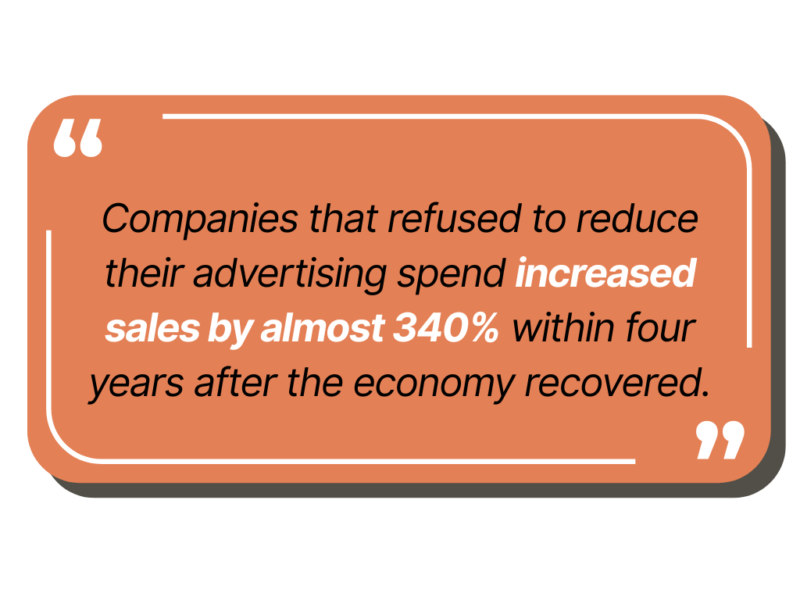
More recently, during the COVID-19 pandemic, brands that maintained visibility and adapted their messaging appropriately saw significant benefits. A survey revealed that 65% of customers cared about a brand’s activities during the crisis, with those perceptions influencing purchasing decisions well beyond the immediate situation.
This pattern repeats across multiple economic downturns: companies that view marketing as an investment rather than an expense emerge stronger, while those that retreat to save costs often struggle to regain momentum when conditions improve.
Why Digital Marketing Specifically Matters in a Recession
While all forms of marketing can be valuable during a recession, digital marketing offers distinct advantages that make it particularly effective during economic uncertainty:
Cost-Effectiveness and Measurability
“Digital marketing channels often provide a more cost-effective approach compared to traditional marketing methods,” explains Chad Bittle, an Email Marketing Manager at Thrive Agency. “With tighter budgets during a recession, investing in digital marketing allows businesses to reach their target audience without breaking the bank.”
Unlike traditional advertising, digital marketing provides precise measurement of performance, allowing marketers to track and maximize conversion opportunities. This data-driven approach enables businesses to make informed decisions about where to allocate limited resources, ensuring every marketing dollar works as hard as possible.
Flexibility and Adaptability
Economic downturns often require quick pivots in messaging and strategy. Digital channels allow for rapid adjustments without the lead times and sunk costs associated with traditional media. As consumer priorities shift during a recession, digital marketers can test new approaches, monitor results in real-time, and refine their tactics accordingly.
This adaptability is crucial when navigating uncertain economic waters. A message that resonated before the recession may fall flat or even appear tone-deaf during challenging times. Digital platforms enable marketers to stay attuned to changing consumer sentiment and adjust accordingly.
Changing Consumer Behavior
Recessions fundamentally alter how consumers make purchasing decisions. People spend more time researching options, comparing prices, and seeking reassurance before committing to purchases. This increased deliberation makes a strong digital presence more important than ever.
“During a recession, it’s essential to acknowledge the challenging times and show empathy towards customers,” Bittle advises. “Address their pain points, offer support, and provide value. This can help build trust and strengthen the customer-business relationship.”
With consumers spending more selectively, being visible and accessible online—where most of this research happens—is critical for staying in consideration.
The Psychological Impact: What Your Marketing Says About Your Brand
Your marketing activities during a recession send powerful signals to customers, competitors, and investors about your company’s stability and confidence. Scrambling to pull advertising and cut back on marketing activities suggests your business is worried about its financial future, which can negatively impact consumer confidence and even affect capital fundraising efforts.
Conversely, maintaining a consistent presence communicates strength and reliability—qualities that become even more valuable during uncertain times. As Michael Transon of Victorious notes, “Continued marketing activities signal stability,” while radical changes to your marketing plan “may be taken as a sign that something is wrong with your business.”
This psychological dimension extends beyond perception to actual competitive positioning. When your competitors abandon their marketing campaigns to save costs, you have a unique opportunity to increase your share of voice and capture the attention of consumers who might otherwise have chosen competitor brands.
Digital Marketing Strategies That Thrive During Recessions
Not all digital marketing tactics perform equally well during economic downturns. Here are the strategies that typically deliver the strongest results when budgets are tight:
SEO: The Foundation of Recession-Proof Marketing
Search engine optimization becomes particularly valuable during recessions for several reasons. First, it drives organic traffic without requiring ongoing ad spend. Once you’ve established strong rankings, you continue to receive visibility without paying per click or impression.
Second, SEO aligns perfectly with recession-influenced consumer behavior. As people conduct more research before making purchases, being visible in search results becomes crucial. According to Dan Casey, an SEO Manager at Thrive, “You will find in a recession many businesses are not allocating a normal portion of their marketing budget, leaving the door open for competitors to outrank them.”
A family-run travel business provides a compelling example of SEO’s recession-fighting power. Just before the pandemic devastated the travel industry, they doubled down on their SEO efforts, creating content specifically targeted to address traveler uncertainty. Their organic traffic more than doubled during the first year of the pandemic, and they captured valuable keywords that continue to bring high-quality traffic to their site.
Content Marketing: Building Trust When It Matters Most
Content marketing consistently delivers three times more leads per dollar than paid search, making it particularly effective during periods of budget constraints. During recessions, consumers seek information, reassurance, and guidance before making purchases—precisely what good content marketing provides.
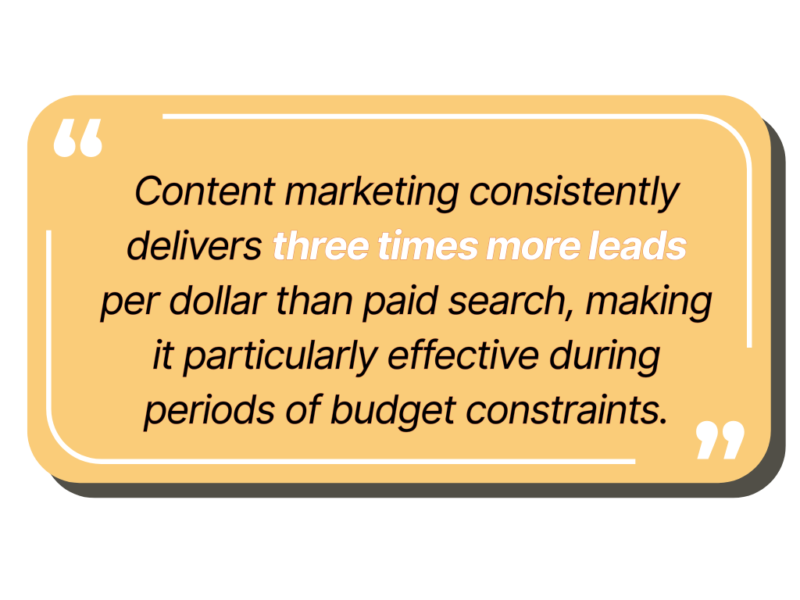
Focus on creating educational content that addresses recession-specific concerns. Guides like “How to Maximize Value During Economic Uncertainty” or “5 Ways to Make Smarter Purchasing Decisions in 2025” demonstrate your understanding of customer challenges while positioning your brand as a helpful resource.
Evergreen content that covers the entire buyer’s journey becomes especially valuable during recessions. As Sagefrog advises, “Leverage individual, evergreen content pieces that build awareness of a challenge, point to a potential solution, and then sway a lead toward choosing your solution.”
Email Marketing: Nurturing Relationships at Minimal Cost
Email marketing provides a direct line to existing customers and prospects at a fraction of the cost of many other channels. During recessions, nurturing these relationships becomes even more important than acquiring new customers.
Prioritize growing and activating your email and SMS lists, which provide communication channels unaffected by advertising auction dynamics. These owned audiences become critical assets during economic uncertainty, allowing you to maintain customer relationships without ongoing acquisition costs.
Segment your email lists to deliver more relevant content based on how different customer groups are responding to economic conditions. For example, create specific segments for customers browsing high-priced or recession-affected products, and develop messaging that addresses their potential hesitation while reinforcing your value proposition.
Social Media: Maintaining Engagement without Major Investment
Social media allows brands to maintain visibility and engagement without necessarily requiring large financial investments. During recessions, these platforms become important channels for communicating your brand’s response to economic challenges and demonstrating empathy with customer concerns.
However, be mindful of tone and context. During the COVID-19 pandemic, 38% of consumers thought using humor in marketing was inappropriate. Instead, focus on helpful, supportive content that acknowledges current realities while offering practical value.
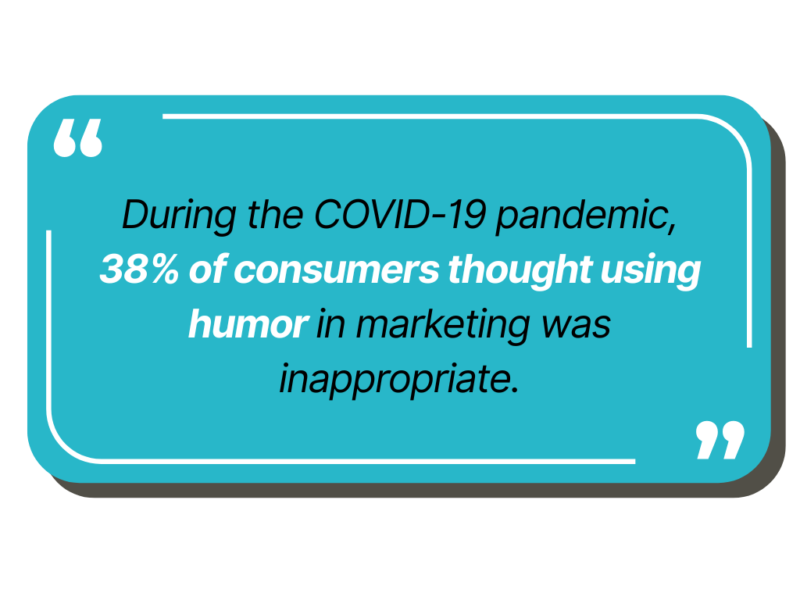
PPC Optimization: Getting More Value from Every Click
While some businesses might be tempted to eliminate paid advertising entirely during a recession, a more strategic approach is to optimize these campaigns for maximum efficiency. As competitors reduce their ad spend, you may see lower costs per click and better placement opportunities.
“Watch for CPC drops as competitors pull back spending,” advises Seer Interactive, noting that changes like the end of the De Minimis exemption for sub-$800 shipments from China “could hit DTC giants like Shein and Temu—major players in Google and Meta’s ad auctions.” These shifts may create unexpected opportunities in previously competitive keyword auctions.
Focus on improving your Google Ads cost-per-click (CPC) by leveraging long-tail keywords, implementing negative keywords, and scheduling ads strategically. These optimizations can significantly improve the ROI of your paid campaigns even with reduced overall spend.
Budget Optimization Tactics for Recession Marketing
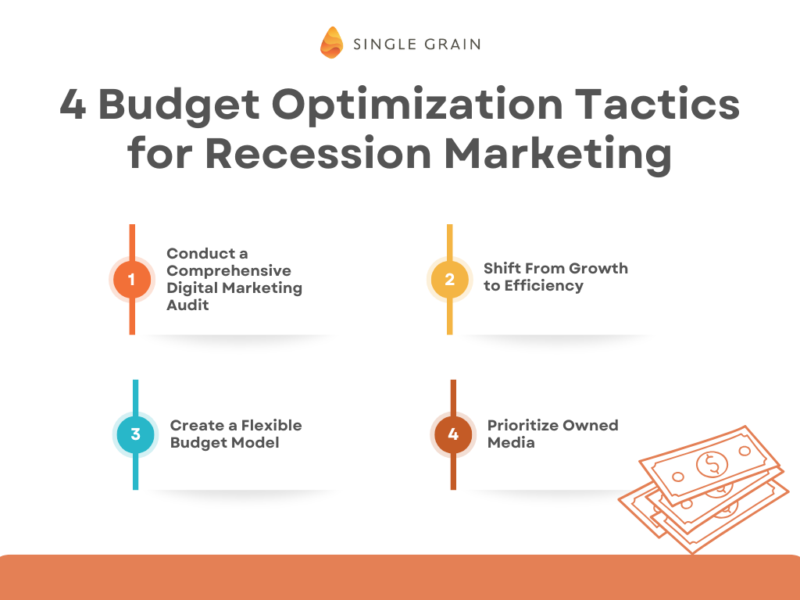
Rather than implementing across-the-board cuts, successful marketers take a surgical approach to budget reallocation during recessions:
Conduct a Comprehensive Digital Marketing Audit
Begin by evaluating which marketing efforts deliver the most value. Analyze channel performance, customer acquisition costs, conversion rates at each funnel stage, and customer lifetime value by segment. This data-driven approach allows you to reallocate your marketing budget strategically, cutting underperforming initiatives while strengthening successful ones.
Shift From Growth to Efficiency
During economic growth periods, marketing often focuses on expansion and acquisition. Recessions call for a pivot toward efficiency and retention. Reserve your advertising inventory “for known winners and margin accretive products” while deprioritizing broad brand campaigns during this period of adjustment.
Create a Flexible Budget Model
Consider implementing a flexible budget model that allows for quick pivots based on performance data. Set aside a portion of your budget (10-15%) as a “response fund” that can be deployed opportunistically when you identify channels or products performing above expectations despite the challenging environment.
Prioritize Owned Media
As paid media costs fluctuate and margins tighten, owned and earned channels become increasingly valuable. Double down on SEO and evergreen content creation that will continue generating traffic long after publication. While competitors focus on short-term performance, investing in organic visibility can create sustainable competitive advantages that persist beyond the current economic situation.
Content and Messaging Adjustments for Recession Audiences
Your marketing message needs to evolve in response to changing economic conditions:
Emphasize Value Over Price
For premium products facing price sensitivity, develop messaging that reinforces value over cost. Emphasize durability, long-term value, and quality differentiators that justify the premium. As Bryan Gildenberg notes, most discretionary purchases during recessions face “price point trade down or deferring purchase” decisions from “sticker-shocked shoppers.” Your content should address this directly.
Transparency About Economic Challenges
Create educational content that addresses consumer concerns directly. Add FAQ schema and messaging banners to relevant product pages explaining current conditions, which can improve both user experience and SEO performance. Transparency builds trust, which becomes even more valuable during uncertain times.
Balance Empathy with Optimism
While acknowledging economic challenges, avoid dwelling exclusively on negative aspects. Consumers seek both understanding and reassurance during recessions. Strike a balance between empathizing with difficulties and offering positive, forward-looking perspectives that help customers envision a path forward.
Customer Retention: The Recession Marketing Priority
During economic uncertainty, customer retention becomes even more valuable than acquisition:
Implement Loyalty Programs
Develop loyalty programs that incentivize repeat purchases despite economic pressures. Consider offering tiered benefits that reward continued engagement, or bundle complementary products to maintain average order values even as consumers become more price-sensitive.
Focus on Conversion Rate Optimization
As Jason Landro, co-CEO of digital marketing agency Nectar, advises: “Focus on improving your conversion rates. Attempt to increase click-through rates.” These optimization efforts can help maintain performance even with reduced top-of-funnel investment.
Eliminate roadblocks between prospects becoming clients by optimizing webpages to encourage desired actions. Submission forms, contact buttons, and calls to action should be strategically placed and tested to maximize conversions from existing traffic.
Leverage Retargeting Strategically
Create specific segments for customers browsing high-priced or recession-affected products, and develop retargeting strategies that address their potential hesitation. Set up abandoned cart recovery workflows with messaging that acknowledges price concerns while reinforcing your value proposition.
Measuring Success: KPIs for Recession Marketing
During recessions, some metrics become more important while others may need recalibration:
Adjust Expectations and Benchmarks
Historical performance data may not provide realistic benchmarks during economic downturns. Establish new baselines that account for changed market conditions, and focus on relative performance compared to competitors rather than year-over-year growth alone.
Prioritize Efficiency Metrics
Metrics like customer acquisition cost (CAC), customer lifetime value (CLV), and the ratio between them take on heightened importance during recessions. Similarly, conversion rates, email engagement metrics, and organic traffic growth can indicate marketing effectiveness even when overall revenue growth slows.
Implement More Frequent Reviews
Economic conditions can change rapidly during recessions. Rather than quarterly marketing reviews, consider monthly or even bi-weekly assessment of key performance indicators. This increased frequency allows for more agile responses to changing market dynamics.
Implementation Timeline: A Phased Approach
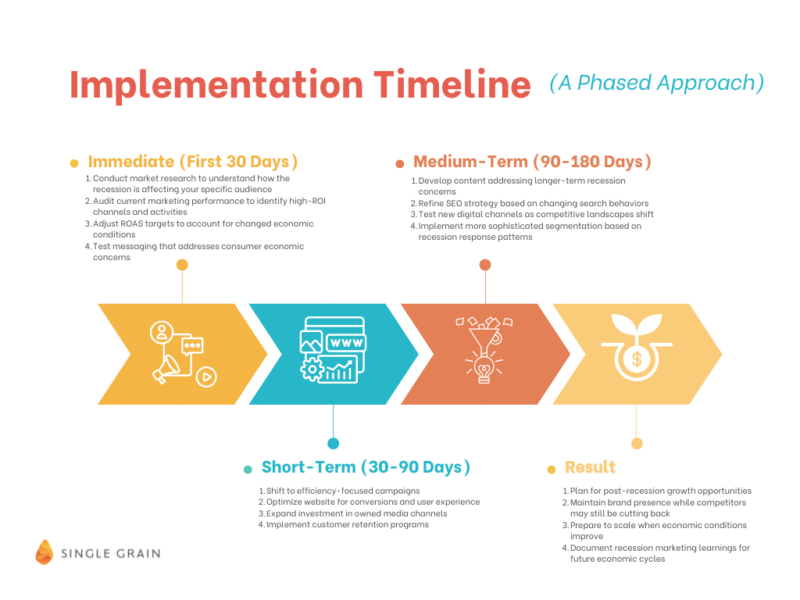
Implementing these strategies requires a thoughtful, phased approach:
Immediate (First 30 Days):
- Conduct market research to understand how the recession is affecting your specific audience
- Audit current marketing performance to identify high-ROI channels and activities
- Adjust ROAS targets to account for changed economic conditions
- Test messaging that addresses consumer economic concerns
Short-Term (30-90 Days):
- Shift to efficiency-focused campaigns
- Optimize website for conversions and user experience
- Expand investment in owned media channels
- Implement customer retention programs
Medium-Term (90-180 Days):
- Develop content addressing longer-term recession concerns
- Refine SEO strategy based on changing search behaviors
- Test new digital channels as competitive landscapes shift
- Implement more sophisticated segmentation based on recession response patterns
Long-Term (180+ Days):
- Plan for post-recession growth opportunities
- Maintain brand presence while competitors may still be cutting back
- Prepare to scale when economic conditions improve
- Document recession marketing learnings for future economic cycles
Looking Forward: Positioning for the Recovery
While navigating the immediate challenges of a recession is crucial, the most strategic marketers also keep one eye on the eventual recovery. The groundwork you lay during the downturn will determine how quickly and strongly your business rebounds when economic conditions improve.
By maintaining visibility while competitors retreat, you position your brand for accelerated growth when consumer spending rebounds. The market share gains made during economic disruption can persist long after conditions normalize, creating lasting competitive advantages.
For B2B marketers looking to maximize impact during these challenging times, tools like Karrot.ai can help transform your LinkedIn ads with 1-1 personalized messaging that converts more effectively—exactly what’s needed when every marketing dollar must demonstrate clear returns. By delivering individualized messages without sacrificing scale, Karrot helps you make every advertising dollar work harder during periods of economic uncertainty.
The businesses that will emerge strongest from economic downturns are those that view digital marketing not as an expense to be cut, but as a strategic investment in future growth and market position. By following the strategies outlined in this article, you can turn a challenging economic environment into an opportunity to strengthen your brand and outpace competitors who lack the courage to maintain their marketing presence during uncertain times.




